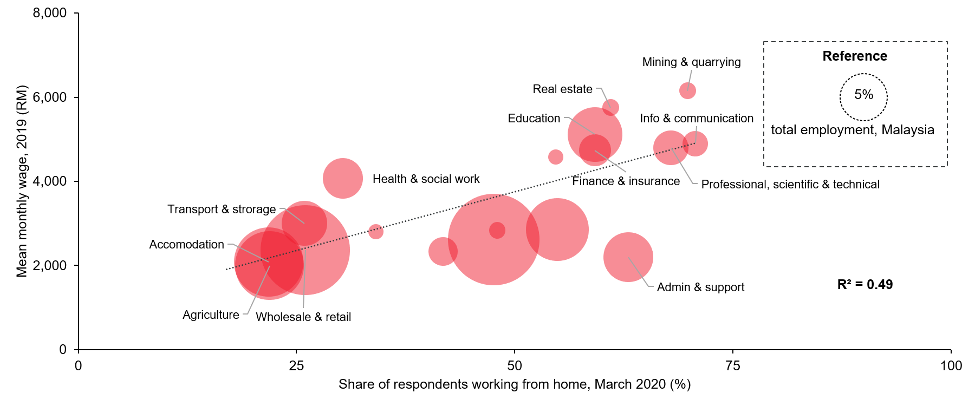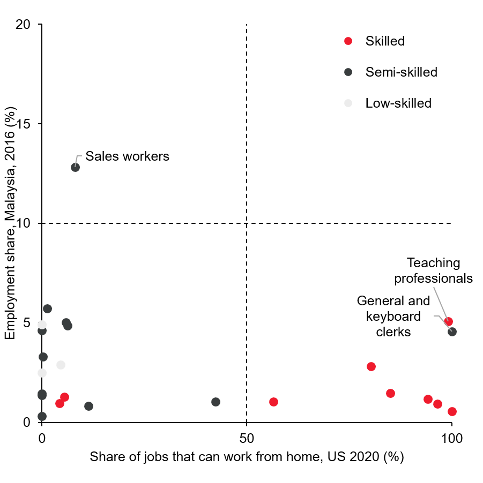“Working from home is vaunted as the “new normal” as Covid-19 continues to spread and vaccination is yet to become available. However, gaps in digital infrastructure and the nature of work across the country mean that this working arrangement is unlikely to be the “new normal” for most workers in Malaysia.”, writes Siti Aiysyah Tumin, a researcher at Khazanah Research Institute, a policy think tank in Malaysia.
_______________________________________________
To contain the spread of Covid-19, the Malaysian government introduced the Movement Control Order (MCO) on 18 March 2020. The order included the closure of public and private premises, halting most economic activities in the country except for several essential services. Consequently, many workers were made to work from home. Although the MCO was subsequently replaced by a recovery phase in which workers could return to work, working from home might persist for some workers as vaccines are still being developed.
But how much work can be done from one’s home? This article discusses the viability of working from home, given Malaysia’s current digital infrastructure and the nature of employment. The pandemic also increases the push for businesses to digitalise and automate some of their operations, putting some jobs at higher risks of displacement as compared to others.
What happened to workers?
When the MCO started, 44% of workers surveyed by Malaysia’s Department of Statistics (DOS) reported that they worked from home, as most business activities halted (Figure 1). However, this working arrangement was only prevalent among standard workers or employees . These refer to workers who work for public or private employer and receive regular wages, and they are the most common employment type in Malaysia (74% of total employment in 2019). In contrast, only one in four self-employed people surveyed were able to work from home (Figure 2). Job loss was also reported among one in ten survey respondents, and unsurprisingly, official unemployment figure in March 2020 was 3.9%, much higher the 3.3% average unemployment in 2019. The rate peaked in April 2020 (5.0%) and remained high at 4.7% in July 2020 (DOS, 2020d).

Figure 1: COVID-19 effects, March 2020. DOS (2020e)

Figure 2: Share of COVID-19 effects by employment statuses, March 2020. DOS (2020e)
Although the survey carried out by DOS was non-representative, its findings are useful to identify some working-from-home trends in Malaysia. Respondents who worked from home when the pandemic started were mostly employed in highly paid economic activities (Figure 3), which cumulatively made up less than one-third of Malaysia’s workforce in 2019. This could imply the inequality effects of the pandemic; well-paid workers were the immediate ‘economic survivors’ of the containment measures as they continued to work from home, but workers earning lower incomes were more likely to be its ‘economic victims’ as they had to stop working.

Figure 3: Mean wages (2019), share of respondents working from home (March,2020), share of employment (2019), by sector. DOS (2020e), DOS (2020f), DOS (2020c)
Who could work from home?
A more fundamental question of working from home is who could work from home? This article explores two determinants: 1) infrastructure to support working from home and 2) nature of work.
Infrastructure to support working from home
Intuitively, working from home depends on whether workers are appropriately equipped with the necessary hardware and internet connectivity at home. Nationally, 71.3% of households have computers, and 90.1% have an internet connection (DOS, 2020b). However, there is some variation in the extent of connectivity, as observed in Figure 4. Expectedly, richer areas of the country are more connected, indicating that not all households are equipped with the infrastructure to enable working from home.

Figure 4: Median household income, share of households with internet connection and computer, by district, 2019. DOS (2020b), DOS (2020a)
Moreover, businesses might not be ready to support work-from-home arrangements. In 2019, only establishments in ICT, real estate and finance sectors had 100% computer and internet access, but they employed about 5% of the workforce, typically located in more advanced states in the country. Moreover, most establishments’ internet access and computer network are tied to the physical workplace —81% relied on fixed broadband, 55% used local area network and 36% used wireless local area networks. In other sectors, the absence of mobile hardware and internet access limits the ability of workers to work from home (DOS, 2019).
It is not surprising that as of 2019, only about 11% of households reported that they used the internet to “work from home” (DOS, 2020b). To enable more working from home arrangements during Covid-19, the Malaysian government has provided additional tax reliefs for the purchase of technological devices to enable working-from-home arrangements. However, the ability to work from home also depends on the nature of work.
Nature of work
Nature of work refers to whether the context of a job and/or the tasks required by a job allow workers to work from home. For example, if a job requires workers to be outdoors every day, or if the task associated with the job is to handle and move objects, the job cannot be done from home. In the United States, it was estimated that, at most, 37% of jobs can plausibly be performed at home (Dingel and Neiman, 2020). Meanwhile, the estimate for the European Union was around 17%, varying across sectors (ILO and Eurofound, 2017).
Using estimates from the US, Figure 5 shows that skilled jobs are more plausible to be performed at home, compared to semi-skilled and low-skilled jobs—but less than one-third of the country’s workforce are employed in skilled occupations. With some assumptions, mapping the estimates from Dingel and Neiman (2020) with employment figures reported in KRI 2018, at most only 28% of jobs in Malaysia could be done from home. Abdur Rahman, Jasmin and Schmillen (2020), using a different dataset, estimated 65% of jobs cannot be performed from home after adjusting for internet access.

Figure 5: Share of employment (Malaysia, 2016) and share of jobs that can be done at home (the US, 2020), by occupation. Estimated from Dingel and Neiman (2020), data adapted from KRI (2018)
Essentially, working from home is biased to skilled employment, compared to semi-skilled and low-skilled employment. These kinds of jobs are not only paid much better, but also tend to cluster in urban and richer parts of the country too. Meanwhile, semi-skilled and low-skilled jobs tend to concentrate in lower-income states. Given these disparities, the viability of working from home among Malaysian workers will also be uneven; not only because of the challenges of digital infrastructure, but also because of the nature of jobs in the country.
The push for digitalisation and automation
The push to digitalise and automate in Malaysia started even before the pandemic through various incentives for firms to embrace technological advancement and Industrial Revolution 4.0. During Covid-19, businesses are likely to be more incentivised to embrace technology to remain resilient. If most operations can move online, business will only be marginally affected by physical containment measures during the pandemic.
Additionally, Covid-19 situates workers along the lines of infection risk: the contexts of some jobs and tasks require close or frequent physical proximity to others, making some workers more vulnerable to infection. For example, a server at a restaurant is more likely to get infected because their job requires them to interact and be in close contact with more customers, compared to a chef in the same restaurant. Using estimates from ONS (2002), where each job is scored based on the extent of workers’ physical proximity to others, Figure 6 illustrates the links to the relationship with their likelihood to be automated, as estimated by KRI (2017). Worryingly, a large segment of the Malaysian workforce is in the region where jobs face higher infections risks and can be automated (top right quadrant of Figure 6). In other words, many workers face the double whammy of job displacement risks due to technological advancements annd infection risks due to COVID-19.

Figure 6: Average score of proximity to others (the US, 2020), risk of automation (the US, 2013) and share of employment (Malaysia, 2016), by occupations. Estimated from (ONS, 2020), automation risks from (KRI, 2017) and Malaysian employment data from (KRI, 2018)
Conclusion
Working from home is vaunted as the “new normal” as Covid-19 continues to spread and vaccination is yet to become available. However, gaps in digital infrastructure and the nature of work across the country mean that this working arrangement is unlikely to be the “new normal” for most workers in Malaysia. This highlights two key considerations for policymakers: One, assistance to workers and households is especially important when countries implement physical containment measures because most jobs cannot simply shift to be home-based. On this front, Malaysia has implemented initiatives such as direct cash transfers and wage subsidies to help as many workers as possible. Two, ensuring safety at the workplace is still the main priority for policymakers. This will require frequent supervision of the workplace to ensure that safety and health standard operating procedures are implemented, which might require additional manpower and resources from the government.
At the back of this global health crisis, the role of technology in the world of work becomes particularly important. Digitalisation and automation are some of the ways for businesses to be more productive, and are even necessary to survive during Covid-19. However, there are potentially dire implications for workers. Jobs most affected by Covid-19, either because they cannot be home-based or face higher infection risks, also happen to be jobs that can be automated. In the case of Malaysia, most employment is concentrated in these jobs, putting many workers at risk of being displaced. Nonetheless, not all is lost. The adoption of new technology takes time, and it is paramount that policymakers use this time lag to manage the potential labour-displacement effects. Incentives and support for businesses to modernise should be complemented by efforts to upskill workers along the way. Moreover, not all jobs can be automated. Essential services such as education and healthcare are human-centric and will continue to require workers. If anything, Covid-19 emphasises how important these services are for society. New jobs could also be created as the economy modernises. Active labour market policies, particularly job training and upskilling programmes, must be strengthened to support the transition of workers to these economic activities.
References
Abdur Rahman, A., Jasmin, A. F. and Schmillen, A (2020). The Vulnerability of Jobs to COVID-19: The Case of Malaysia. ISEAS Yusof Ishak Institute.
Dingel, J. I. and B. Neiman (2020). How many jobs can be done at home?, National Bureau of Economic Research.
DOS (2019). Usage of ICT and E-commerce by Establishments, 2018, Department of Statistics.
DOS (2020a). Household Income and Basic Amenities Survey Report, Malaysia, 2019, Department of Statistics.
DOS (2020b). ICT Use and Access by Individuals and Household Survey Report, Malaysia, 2019, Department of Statistics.
DOS (2020c). Labour Force Survey Report, 2019, Department of Statistics.
DOS (2020d). Labour Force, Malaysia, July 2020, Department of Statistics.
DOS (2020e). Report of Special Survey on Effects of COVID-19 on Economy & Individual – Round 1, Department of Statistics.
DOS (2020f). Salaries & Wages Survey Report, Malaysia, 2019, Department of Statistics.
ILO and Eurofound (2017). Working anytime, anywhere: The effects on the world of work, International Labor Organization.
KRI (2017). “The times they are a-changin’: Technology, employment, and the Malaysian economy.”
KRI (2018). “The state of households 2018: different realities.” Khazanah Research Institute.
ONS (2020). Which occupations have the highest potential exposure to the coronavirus (COVID-19)?, Office of National Statistics, UK.
* The views expressed in the blog are those of the authors alone. They do not reflect the position of the Saw Swee Hock Southeast Asia Centre, nor that of the London School of Economics and Political Science.
* This article is based on How Common is Working from Home? a discussion paper on the viability of working from home for Malaysian workers. The author is grateful for comments on the paper and this article from Ahmad Ashraf Ahmad Shaharudin, Dr Rachel Gong, Hawati Abdul Hamid, Nur Thuraya Sazali, Anne Sharmila Selvam and Amos Tong. All errors remain the author’s own.






a very descriptive research and useful reading material to understand how COVID had changed the people’s life and economy